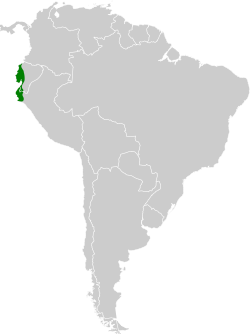| Crimson-breasted finch | |
|---|---|
 | |
| Scientific classification | |
| Domain: | Eukaryota |
| Kingdom: | Animalia |
| Phylum: | Chordata |
| Class: | Aves |
| Order: | Passeriformes |
| Family: | Thraupidae |
| Genus: | Rhodospingus Sharpe, 1888 |
| Species: | R. cruentus |
| Binomial name | |
| Rhodospingus cruentus (Lesson, 1844) | |
 | |
The crimson-breasted finch (Rhodospingus cruentus), is a species of small finch-like bird native to woodland and scrub of western Ecuador and adjacent north-western Peru. It is the only member of the genus Rhodospingus. It has traditionally been placed in the family Emberizidae, but molecular phylogenetic studies have shown that it belongs to the tanager family Thraupidae. It is strongly sexually dichromatic, with males being blackish above and rich orange-red below and on the crown, while females are overall dull greyish-buff.


